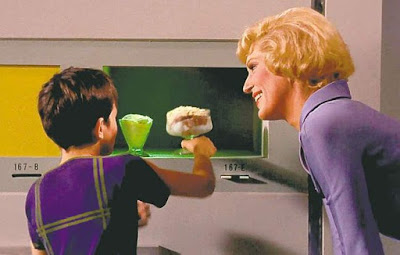Tomorrow’s Tech … Today!
Many futuristic inventions have come to pass, while some may
never be realized.
HYPERSPACE / POCKET UNIVERSE
You might
call this concept a parallel universe to hold your leftovers. Official Marvel Comics doctrine is that
shapeshifters send extra mass or energy there and bring it back at will. After a 1986 reboot of the entire DC
universe, John Byrne hand-waved a “pocket universe” into existence to preserve
the big-selling Legion of Super-Heroes title, and Superboy’s presence in it
(since Superboy had been doctrinally removed).
This is
familiar to many folks as a videogame trope, an endless backpack from which to
pull weapons or other tools whenever your points or energy are high enough.
While it’s a
nice theory, there’s no current science that suggests how to access these
hypothetical supply closets, or even their possible existence. Asimov’s 1972 The Gods Themselves points out one danger inherent in
tapping a hyper-dimension for supplies:
What if the other side is leeching from you, too? For that matter, what if they want their
stuff back?
And even more
important, wouldn’t it be great if, instead, you could take a “pocket nap”?
***********************************************************
BIONICS
Peg legs, Captain Hook, and wooden dentures
aside, IRL manufactured organ replacements began with the Jarvik artificial heart,
first implanted in 1982.
A decade
earlier, Martin Caidin’s novel Cyborg started the fictional trope
of replacement parts, developing into Star Trek’s Borg and Luke
Skywalker’s replacement hand. On this
Earth, limbs are easier to replace than
organs, with some hand models possessing grip facilities detected by nerve
impulses.
However, there’s
no foreseeable future for a brain-in-a-jar running machinery, as in The
Ship Who Sang and many Golden Age SF tales. It looks as if Dr McCoy was right when, in
“The Menagerie,” he talked of the medical difficulties involved with jacking
into the human brain.
REPLICATORS
Star Trek TOS had “food
processors.” They were called
“replicators” in TNG, and were byproducts of transporter technology, converting
bulk materials into a desired molecular pattern. “Earl Grey, hot,” anyone?
3-D printers
have been available since the early 2000s, but are presently limited to
nonorganics. In 2005, researchers
reported success in using “cell jet printers” to print first bacteria and even
mammalian cells. A company named Digilab
sells the “CellJet Cell Printer.” Stay
tuned!
**************************************************************
FOOD PILLS
One of the
fond ideas of the Industrial Revolution was concentrated food, usually called
“food pills.” William Hope Hodgson's The
Night Land (1912) is one of the earliest examples of this, with food
tablets as well as "dehydrated water" (!) in the far future. In The Patchwork Girl of Oz (1913),
Professor Wogglebug has invented Square Meal Pills. Other literary references include Ray
Bradbury tales, and Stephen King’s The Running Man. In films and video, 1964's Santa
Claus Conquers the Martians includes
Ice Cream or Cake food pills. Star
Trek’s Kelvans used food pills, and similar things appeared in a few Lost
in Space episodes. Food
concentrates are also familiar from The Jetsons and Futurama.
But, as a
2010 Time.com
article about failed predictions points out, given a standard adult
2000-calorie diet, present technology would still require you to choke down a
pound or so of pills a day. And besides,
who would rather pop a pill than eat a knish or a hamburger?
***********************************
See you Thursday!
























No comments:
Post a Comment